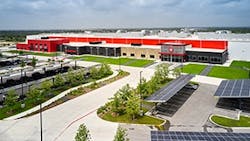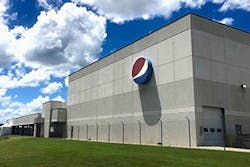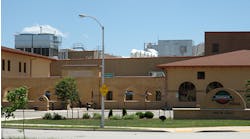What’s on the minds of the people building or expanding food and beverage plants?
A big concern is getting people inside that new or expanded building.
As the country stumbles through what we hope is the end of the pandemic, the food and beverage industry – like the rest of American business – continues to grapple with labor issues. It’s liable to be a long-term problem, which is why many companies designing new plants or other capital projects are taking labor-saving features – primarily automation – into account.
2022 Capital Spending Outlook
In our 2022 Capital Spending Outlook, we look at the 33 biggest publicly traded, U.S-. and Canadian-based food and beverage processing companies to see where they're spending their money. See what they're spending and what they're spending it on. Visit our Equipment Resource Library to download the 2022 Report
Of the 33 publicly traded corporations in Food Processing’s Top 100 for 2021 list, 26 have budgeted more for capital projects in 2022 than they spent in 2021.
“What we’re witnessing in requests from clients is 'How do we start to address labor with automation and technology?' ” says Jason Robertson, vice president of the food and beverage group for design and construction firm CRB.
Automation, of course, can take many forms, from equipment with enhanced intelligent operation, to robots, to automatic guided vehicles and automatic storage and retrieval systems. Existing automation can be routinely incorporated into new plants or lines. Accommodating future stages of automation, designers say, is often simply a matter of leaving space: overhead for wiring, in aisles for guided vehicles, and just in general for equipment that may have to be brought in to enhance a line’s operation.
“At Stellar, we have certainly seen an increase in automation-focused projects that employ robotics and other IIoT technology,” says Derek Bickerton, vice president of business development at The Stellar Group. “One of the main drivers of this trend is the current labor market. Our clients have had difficulty attracting and retaining employees, particularly in cold storage or other low-temperature working environments. In addition, automated storage and retrieval system (ASRS) projects are growing in popularity.”
Distant questions
The pandemic is influencing plans and choices in capital projects in other ways. One of the biggest questions that planners have to ask themselves is whether to include social distancing, or at least the potential to implement it, into the designs.
Some say they are. “Overall, our clients are factoring the pandemic into their decisions when it comes to operations at current facilities as well as planned projects for the future,” Bickerton says. “The primary component of this has been prioritizing employee separation, whether on processing lines or in management offices.”
Jason Jones, a senior partner at The Dennis Group, agrees. “The COVID-19 pandemic is going to have a long-term impact on the design of food manufacturing facilities, particularly in relation to space planning and traffic flow,” he says. “Design modifications made in response to the pandemic such as reducing shared workspaces, spacing and separating workers on a line, and improving electronic tracking of personnel movement through a facility will continue to be used after the threat of COVID-19 has diminished.”
Even though safety measures like thermal imaging cameras and full-body disinfection booths will probably go out of use once we’re out of the pandemic for good, it may very well be prudent to allow room for such measures at entry and exit points to accommodate any future situations, Jones says.
However, space for building social distancing and other measures into a plant design is not easy. It goes against one of the major imperatives of design, which is to use every foot of space as efficiently as possible. Altering that approach is not only expensive, but potentially a needless expense as the pandemic winds down.
That’s why it’s far from a universal approach.
Pet food is seeing a lot of construction activity, like this one for FreshPet being built in Ennis, Texas. Photo: CRB
Robertson says social distancing is not on the minds of customers "as much as it was before. I think it was a bit of a bell curve, if you will, of heightened awareness addressing those concerns,” he says. “I just don’t see that [as much] today.”
Pet food growth
Some other aspects of the lingering pandemic are figuring into capital spending. One of the biggest effects was an explosion in the pet population among consumers stuck at home. Pet food sales zoomed, and this was reflected in capital projects.
Of the 50 sites on our list of top projects, 10 are for pet food, including a $262 million expansion of a Mars Petcare plant in Fort Smith, Ark. The next highest category was meat & poultry, with eight, led by a new bacon processing plant that Tyson Foods is building in Bowling Green, Ky., at an estimated cost of $355 million.
Other segments have been attracting interest, according to Thomas Vigna, senior vice president and head of food & beverage for BHI, the U.S. division of Bank Hapoalim (BHI), an Israel-based commercial bank.
“BHI has participated in financing transactions recently in the CPG space, such as healthy ice cream, Latin foods, packaged drinks and bars,” Vigna says. Facilities for prepared meals are also in higher demand, along with increased e-commerce capabilities. More generally, “companies that were heavily reliant on foodservice revenue, such as selling to restaurants and catering, have needed to shift their focus to direct-to-consumer businesses,” he says.
In general, flexibility is more highly valued than it used to be, observers say. This is partly a reaction to a situation early in the pandemic, where many processors were caught flat-footed by a switch in consumer behavior from eating out to eating mostly or solely at home.
This 315,000-sq.-ft. facility in San Antonio, Texas, was built for Cuisine Solutions to produce sous-vide meals. The solar panels over the parking lot provide shade as well as electricity. Photo: Stellar
R.J. Romano, a managing director with accounting and financial advisory firm BDO Consulting LLC, suggests that the lowest cost isn’t automatically the goal any longer: “The trending strategy around capital improvements focuses on building a more resilient supply chain, whereas in years past cost reduction was the top priority.”
Jones of Dennis Group agrees: “Manufacturers need to be poised to respond quickly to fluctuating market trends, particularly shifts in demand between retail and foodservice clients, so designing for flexibility in the production and packaging space is crucial.”
Designing flexibility into a plant project is, in most cases, first and foremost a matter of allowing enough space: for automation, for increased storage, and for more equipment or even a new line if that should become necessary. These are all things that will also help most operations deal better with supply chain challenges, in both receiving and shipping.
“To mitigate the impact of external pressures like volatile demand, companies should focus on making internal processes efficient and sustainable,” Romano says.
“This additional pressure can affect multiple areas of a company’s supply chain, including capacity, increased lead times, labor constraints and the need for additional storage. All potentially require capital investment, such as adding production lines or expanding a plant to allow for more throughput and raw material storage.”
Build or expand?
One of the most basic decisions in a capital project is whether to build a new facility or expand an existing one. The balance seems to be in favor of the latter. Of the 49 major projects we’ve identified, only 16 are new facilities; the rest are expansions or renovations. That carries over the pattern from last year, when only nine of 34 major products were new.
PepsiCo will increase the capacity of this plant in Georgia fivefold when an expansion is completed.
Andrew Csicsila, managing director for the consumer products practice of AlixPartners, thinks labor is a major factor in this trend.
“I would say they are not investing as much in new plants, from what we have seen,” Csicsila says. “But they are investing in their existing facilities, mostly in automation, mostly on the back ends of the lines where a lot of labor traditionally sits, because there are such tight labor requirements in the industry right now. There are just not enough people to fill roles.” He sees third-party manufacturing as a way for major processors to overcome labor problems.
However, Robertson thinks that over the long term, many companies will have to think about new construction.
“Investment and new capital in aging facilities is starting to really catch up with some of these organizations,” Robertson says. “We just can’t push those old facilities that have food safety compliance challenges, I’ll call it – that’s something we really need to address.”
The pandemic continues to influence choices in capital projects, but it has also intensified challenges that the food & beverage industry was always going to face, sooner or later. As Tyler Cundiff, president of the food and beverage group at Gray, puts it: “The ongoing trends in the industry will certainly revolve around smarter buildings and smarter production lines. Additionally, the question around automation and labor will continue to be at the forefront of boardroom and leadership team discussions.”






